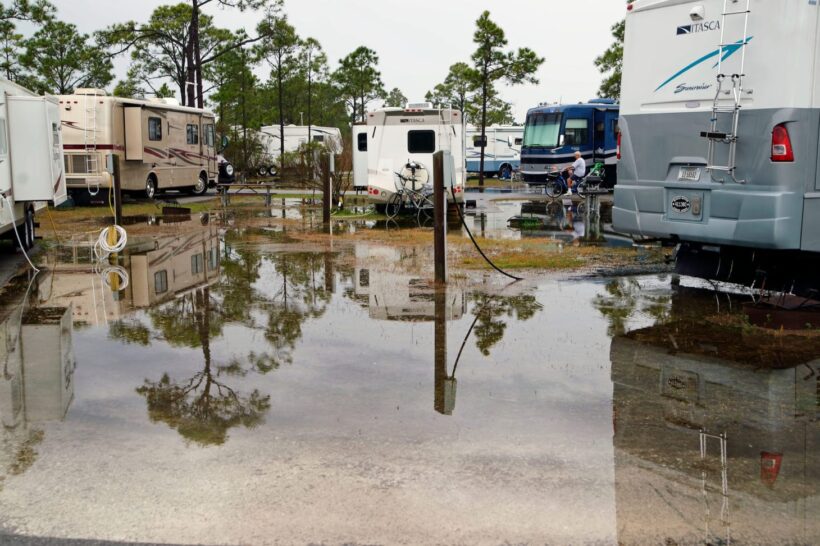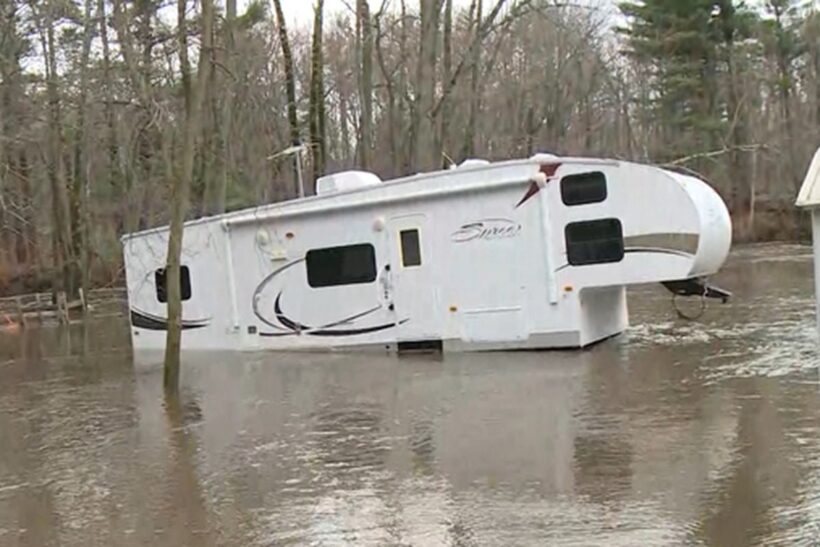Mother Nature can wreak havoc on a recreational vehicle. Hurricanes, tropical storms, and even severe thunderstorms can quickly turn a rig into a flooded and soggy mess. For as soft as it seems, water can cause an exponential amount of damage to an RV. Even a crack in a rig’s roof can allow in enough water to cause expensive repairs over time. However, if a flood has wrecked your rig, a smart way to recoup your losses is to find a buyer. Specialized RV dealers will purchase rain-ravished rigs for more money than you expected.
The Impact of Flooding on RVs

The recent changes to our weather patterns have taken their toll on many a rig. Hurricanes are hitting our coastal areas with increased ferocity, and parts of the country that are typically dry have been hit with massive rainstorms and flooding. These types of events are happening with great frequency, and many RVers have been severely impacted by these ever-occurring one-in-a-lifetime events.
Water has always been a problem for glampers. Cracks in a rig’s roof or loose and ill-fitting window gaskets can allow water to seep inside, causing everything from mold and mildew to delamination. If such small amounts of water can cause so much chaos in an RV, imagine the catastrophic consequences of much larger quantities of water.
What Type of Damage Can Flooding Do to an RV?
RVers who’ve had the unfortunate and sometimes frightening unpleasantness of experiencing a flood while in their rig can tell you how horrifying it can be. Floodwaters are an unstoppable force and, if severe enough, can relocate a motorhome or travel trailer, even with its landing gears down. Any water that’s entered the rig, either from rooftop leaks or being entirely consumed by flood waters, can cause extensive and expensive damage.
Any water intrusion can be a difficult fix. It’ll get into every nook, cranny, and available space, causing mold and mildew to grow. This will not only create an indoor unpleasant odor, but it can also turn into a health hazard. While a flood-damaged RV could possibly have mold growing on every visible and not-so-visit surface, it’ll have other problems, such as:
- Staining or discoloration of interior walls
- Soft spots on walls, ceilings, and floors
- Rust on screws and metal surfaces
- Peeling or cracked caulk
- Compromised gaskets
- Damaged seals
- Delamination of sidewalls, flooring, and roof
Unfortunately, a flooded RV, whether major or minor, will require a lot of elbow grease and effort to get cleaned up. Many times, the damage is so severe that it’ll be deemed totaled by the insurance company. Rigs with extensive water damage could have compromised the integrity of their frame due to water damage, eventual wood rot, and the health hazards of mold and mildew. Getting them back into usable condition could require a complete tearing down and rebuilding.
What To Do With a Flooded RV

Obviously, there isn’t much of a market for flooded or water-damaged RVs. With so many decent and relatively issue-free used rigs for sale, trying to sell a flooded one by traditional methods could quickly prove to be a frustrating waste of time. Even those with minimal flood damage are still considered bottom-of-the-barrel RVs. Specialized RV dealers will purchase rain-ravished rigs for more money than you expected, so you can try to find a junk RV buyer in Illinois for example.
Some water-damaged RV owners will choose to have them repaired, either as a DIY effort or by hiring professionals. Attempting to repair a flooded RV could prove to be far too time-consuming or far too expensive. A lot of the time, the expense costs will be close to or equal to the rig’s resale value. Throwing good money after bad is never a good financial decision.
However, it doesn’t mean that they’re unsalable. RV owners whose rigs have been wrecked by water can get top dollar by selling them to a specialized dealership that purchases all RVs regardless of condition. Age, mileage, or mold doesn’t matter, and a junk RV dealership will come and haul it away, leaving the owner with cash, a check, or a cash app payment.
Preventative Measures
Preventative maintenance is crucial in safeguarding RVs against water intrusion and subsequent damage. Regular inspections and sealing of roof seams and windows can serve as the first line of defense, preventing the deleterious effects of water intrusion. It’s paramount to examine all potential entry points periodically, ensuring that seals are intact and applying a high-quality sealant where needed. Additionally, implementing protective covers and storing the RV in a covered area can further shield it from environmental elements.
Here are some tips for RV owners:
Regular Inspections: Frequently check for cracks, holes, or any signs of damage around the windows, doors, and roof seams.
Quality Sealants: Use high-quality sealants to fix any identified breaches instantly.
Covered Storage: Opt for sheltered or indoor storage to protect the RV from rain and other environmental conditions.
Environmental Consequences

The disposal of water-damaged RVs, if not managed responsibly, can have deleterious environmental impacts. When RVs are scrapped, the resultant waste, if not properly handled or recycled, can contribute to environmental degradation. Hence, sustainable practices, such as recycling and reusing RV materials, are imperative. For instance, metals, plastics, and glass can be extracted and recycled, and undamaged components can be reused in repairing other vehicles. RV owners and repair shops should prioritize sustainable disposal methods to mitigate the environmental impact and promote eco-friendly practices in RV maintenance and disposal.
Insurance Considerations
Comprehensive RV insurance is indispensable for RV owners, offering protection against potential flood damage. A well-rounded insurance plan can alleviate the financial strain associated with repairs and replacements. RV owners should meticulously review their policies to ensure that they encompass protection against water and flood damage. In the event of a flood, documenting all damages meticulously, including photographs and detailed descriptions, can expedite the insurance claims process. Furthermore, maintaining open communication with the insurance provider and understanding the nuances of the policy are essential in navigating insurance claims efficiently.
The Impact of Flooding on RVs: The Bottom Line

Water, whether a large amount or just trickles, can wreak havoc on recreational vehicles. Once it creeps inside, RV owners can expect mold, mildew, odors, and a less structurally sound frame. Oftentimes, the damage water can cause to an RV will cost far too much to fix, leaving their owners confused as to what to do next.
Fortunately, junk RV dealerships come to their rescue. They’ll buy flooded rigs without batting an eye and offer them more than expected. Most offer a free haul-away service. Selling to a specialized RV dealership is a hassle-free way to unload a water-damaged rig. If you have a less-than-desirable RV, give a junk RV dealership a call today.

